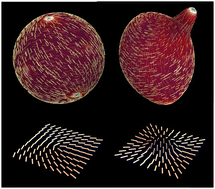Tuneable defect-curvature coupling and topological transitions in active shells†
Abstract
Recent experimental observations have suggested that topological defects can facilitate the creation of sharp features in developing embryos. Whereas these observations echo established knowledge about the interplay between geometry and topology in two-dimensional passive liquid crystals, the role of activity has mostly remained unexplored. In this article we focus on deformable shells consisting of either polar or nematic active liquid crystals and demonstrate that activity renders the mechanical coupling between defects and curvature much more involved and versatile than previously thought. Using a combination of linear stability analysis and three-dimensional computational fluid dynamics, we demonstrate that such a coupling can in fact be tuned, depending on the type of liquid crystal order, the specific structure of the defect (i.e. asters or vortices) and the nature of the active forces. In polar systems, this can drive a spectacular transition from spherical to toroidal topology, in the presence of large extensile activity. Our analysis strengthens the idea that defects could serve as topological morphogens and provides a number of predictions that could be tested in in vitro studies, for instance in the context of organoids.

- This article is part of the themed collection: Soft Matter Recent HOT Articles


 Please wait while we load your content...
Please wait while we load your content...